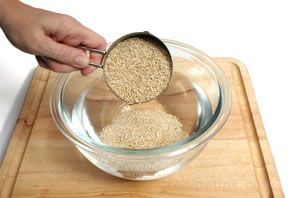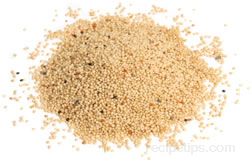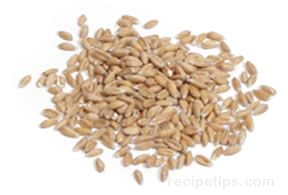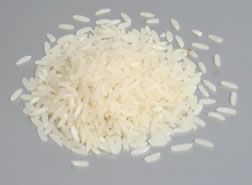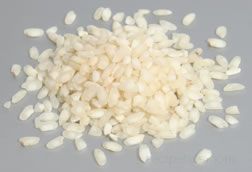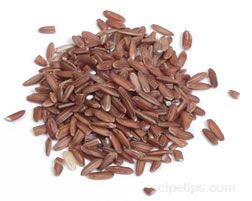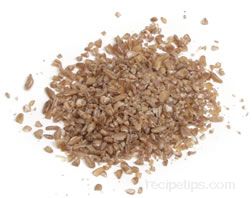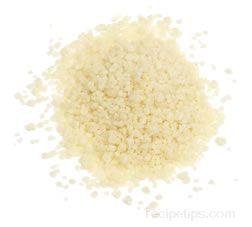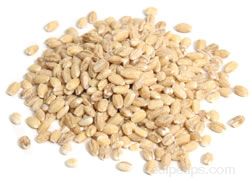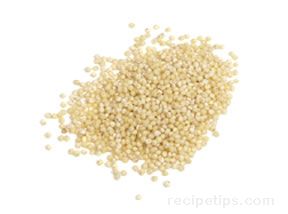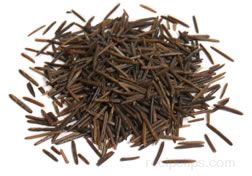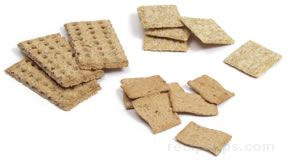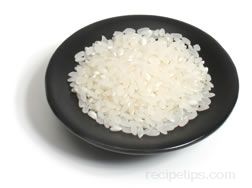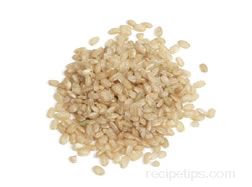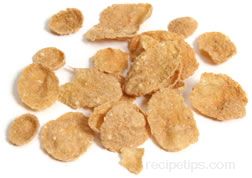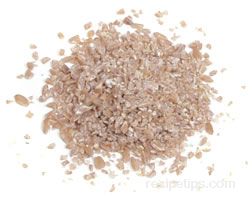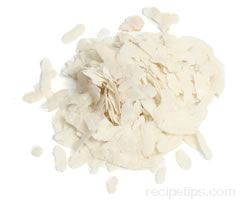Forms of Grain | Types of Grain
Forms of Grain
Whole GrainsWhole grains undergo the least amount of processing of any form of grain because only the outer hull is removed. This means that whole grains require the longest cooking time of any form of grain, but they are the most nutritious form of grain because the nutrient-rich bran and germ are left intact. Whole grains are also referred to as hulled grains. |
Whole-grain Buckwheat |
Pearled GrainsGrain that has been pearled refers to the removal of the bran layers resulting in grain with much less fiber. One advantage of pearled grain is that it cooks faster and is more tender than whole grain. Pearled grain is also known as polished grain. |
Pearled Barley |
GritsGrits are a form of grain in which the kernels have been cut into smaller pieces so that they cook much more quickly. Grits are also known as steel-cut or cracked grains. |
Steel-cut Oats |
Grain FlakesGrain flakes are created with a process in which the grain is steamed and rolled to produce flattened, or flaked kernels, which allows the grain to cook at a much faster rate. Grain flakes are also known as rolled grains. |
Green Rice Flakes |
MealMeal refers to grain that has been ground until it has a course, sandy texture. The meal is often used in breads and cereals. |
Cornmeal |
BranBran is the nutrient packed layers covering the inner kernel of grain. Bran is basically indigestible, but it is loaded with fiber, which is important for digestive health. Some types of bran are so popular as a food supplement that they are sold as a separate product. Oat and rice bran are two of the more popular examples of grains in which some of the bran is removed during processing and ground into a meal to be used as a supplement or food additive. |
Oat Bran |
GermThe germ is the embryo of a kernel of grain, located at the bottom center of the kernel. It is the oily part of a kernel or seed from which a new plant sprouts. It is loaded with vitamins and minerals so it is highly nutritious. The germ also contains fat, which decreases the shelf life of the grain and any grain product containing the germ. |
Wheat Germ |
FlourFlour is a form of grain created by grinding and sifting grain into a powdered form that varies from very soft to coarse in texture. It is used as the main ingredient for making many breads, cakes, pastries, and other types of baked goods. |
Sorghum Flour |
Types of Grain
| Note: For information on the nutritional aspects of various grains, including important information on which grains are gluten free and which are not, see the article, "Grain Nutritional Facts." |
Amaranth
When used as a cereal grain, amaranth can be processed into cereal flakes, added to baked goods such as muffins and breads, or used to make a hot porridge cereal that is crunchy and nutty tasting. Amaranth can also be used as a food extender, for cookies and desserts, or as a side dish similar to potatoes or polenta. The seeds are often milled into flour that can be used for a variety of baked goods and pasta. |
Barley
Barley has a nutty and somewhat sweet flavor and the color of the grain ranges from a light tan to various shades of brown or purple. The outer husk and bran layers are often removed from the barley grain before it is processed further. This is referred to as "pearled" or "polished" barley, which is used to produced barley flour, barley flakes, or barley malt and malt syrup. |
Buckwheat
Buckwheat is grown in many temperate areas of the world including northeastern Europe, Russia, the northeastern United States, areas near the Great Lakes, and in parts of Canada. Three-fourths of the Canadian crop is exported to Japan for the production of the popular soba noodles. Buckwheat seeds or grains are triangular-shaped and are used for hot cereal, sausage filler, soups, and savory side dishes. It is most often ground into flour and used in pancakes, crepes, muffins, and soba noodles. Buckwheat has an earthy, grassy flavor with a slight cocoa taste and it tastes best when the kernels are roasted. It is very hearty and flavorful, although it may seem overpowering to some people. Buckwheat that has been roasted is known by the Russian name "kasha" and unroasted buckwheat is simply called "buckwheat". Roasted buckwheat is darker in color and has a stronger flavor than unroasted. |
CornIn addition to rice and wheat, corn is one of the three most important grain crops in the world. It is a tall cereal plant (growing to a height of up to 10 feet) that is immediately recognizable because of its long, drooping leaves extending from an inner stalk and strong jointed stems supporting large ears ranging in length from a half foot to one foot, which contain the corn kernels. Corn is native to the Western Hemisphere and most of the world's production occurs in the Midwest and Plains states of the United States. In most of the world, corn is known as maize. Outside the United States, the word corn is often used as a generic term to describe any type of cereal grain grown in a particular region. The different varieties of corn are usually among one of the following main types: Dent Corn
Dent Corn is a type of corn that is named for the indentation on the top of the kernels that develops as the corn dries in the field. Most of the corn grown in the United States is dent corn, which is also known as field corn. Dent corn is low in sugar content and high in starch with kernels that are very firm. It is primarily used for animal feed and commercially prepared products for human consumption, such as syrups, sugars, cereals, corn chips, starch, oil, liquor, and sweeteners for soft drinks. Non-edible manufactured goods are also produced from dent corn, such as plastics, adhesives, and fuel additives. Flint Corn
Flour Corn As the name indicates, flour corn is grown solely as a source for the production of corn flour. The kernels are starchy and much softer than other types of corn, which allows flour milling to be an easier process. Corn varieties that have drier, harder kernels, such as flint corn, are often ground into coarse meal, but can be difficult to grind into fine flour. Popcorn
White Popcorn and Yellow Popcorn Popcorn is a special variety of dried corn that contains a high moisture content. About 14% of the composition of the kernel is water, which creates steam when the kernel is heated. This causes the popcorn kernels to explode and pop open because the steam cannot escape. Sweet Corn
|
Farro
Farro is processed in a whole or cracked form, either of which can be found in specialty food stores or mail order suppliers. The whole farro cooks slower than the cracked variety and the texture differs considerably when cooked. The cracked form has the appearance of bulgur. Farro grain that has not had the hull removed should be soaked before cooking. When cooked, the texture of farro is firm and chewy, while some American varieties (spelt) become softer. In European countries, farro is often used for polenta and bread recipes. Farro provides a nutty flavor to salads, soups, stews, side dishes, and meat stuffing. |
Flaxseed
Flaxseed is often used as an additional ingredient in yeast breads or sprinkled on cereal and salads. In the United States, most of the flax crop is used to produce linen cloth, paper, twine, and linseed oil, which is an inedible version of flaxseed oil and is used specifically for paints and varnishes. |
Job's Tears
|
Kamut® Grain
|
Millet
Proso Millet and Ragi Millet Millet is a variety of related plants bearing small seeds used as a grain. The plants may grow to a height of up to six feet and feature large seed heads, which bear many tiny seeds ranging in color from bright yellow to rust, depending on the variety. Millet was a popular food source in Europe and Asia for centuries and today it has become an important food source for developing nations in Africa. In the United States, millet is most often used as a popular variety of birdseed. The numerous varieties of millet are cultivated in different areas of the world based on the type of climate in the area. Some varieties favor tropical locations, while other varieties are able to withstand drought. Millet may remain dormant for an extended period and is then able to quickly sprout with the first rainfall, which is one reason why it is such an important food crop in some of the hot, arid nations of Africa. Other varieties thrive in semi-arid, but cool climates (such as the northern Great Plains of the United States and southern Plains of Canada) where the growing season is shorter, allowing a millet crop to be planted as late as early summer and still be ready for harvesting in early fall. Some of the varieties of millet include foxtail, which is most often used for birdseed or for brewing beer (especially in Russia), Pearl, which is primarily used in India as a food source, and Proso, which is the variety most widely available in the United States for human consumption and for various animal feeds. A red colored variety is most often found in Eastern Europe or Asia where it is known as finger millet, also referred to as Bajra, Kel-varagu, Nacher, or Ragi. Another variety found mainly in Europe, Africa, and Asia is light tan in color and more cylindrical in shape and is known as Bulrush millet. Millet has a mild sweetness and crunchy texture and is eaten as a cereal, a side dish, polenta, and as an addition to soups and stews and desserts. The seeds are especially good if they are toasted. |
Oats
Nearly nine-tenths of the oat crop in the United States is used for animal feed. The remainder is processed with a number of methods including steaming, rolling, cutting, and grinding to produce products for human consumption, such as oat bran, oat flakes, oatmeal, and oat flour. |
Quinoa
Common Quinoa
Traditional Quinoa
Inca Red Quinoa Quinoa (pronounced "KEEN-wah") is not a true grain, but the seeds are used as one. The plant, which is part of the same botanical family as beets, reaches a height of up to 10 feet. It produces clusters that contain thousands of tiny bead-shaped seeds that range in color from light beige to yellow to rust to almost black. The plant can grow well in poor soil conditions, and favors cool climates and high altitudes, such as the Andes Mountains of South America. It was the most important grain for the Incan civilization. Much of the quinoa used in the United States is imported from South America. A small quantity of quinoa is cultivated on the slopes of the Rocky Mountains in Colorado. When cooked in water, the seeds increase in size significantly, swelling three or four-fold. The cooked seeds become tender, with a springy texture. |
Rice
Asia supplies most of the world's rice and most of the rice produced in the United States is grown in the lower Mississippi valley and California. Over half of the rice produced in the United States is exported. Rice varieties are available in both white and brown forms. White rice has had the husk, bran, and germ removed (polished), which allows it to cook rapidly. This makes it the most popular, but it is also the least nutritious because of the removal of the bran and germ. White rice is often enriched with nutrients (especially in Western nations), such as iron, niacin, thiamin, and riboflavin, to help restore some of the lost nutritional value. The bran and germ are used to produce rice oil, also known as rice bran oil, which is used as cooking oil. |
Rye
Rye is processed into a variety of forms including whole kernels (berries), flakes, meal, and flour. When the outer hull is removed, the whole grains can be cooked, although they require longer cooking times than other grains. Soaking the berries overnight will decrease the cooking time. Rye berries are used in stews, rice, and vegetable stir-fries. Rye flakes will cook faster and can be used in a variety of dishes, such as soups and stews. Rye flour is available in varieties ranging from light to dark and textures ranging from course to fine. Because rye ferments easily, it is also used in the creation of various alcoholic beverages, such as whiskey and in blends used for some brands of vodka. |
SorghumSorghum is a cereal plant that is native to Africa, but is cultivated in many parts of the world. Sorghum is sometimes confused with millet. The plant is similar to other cereal grasses in that it has leaves that are long and flat and grain heads that have a feathery appearance. There are several varieties that are cultivated with some growing to a height of 20 feet, however most are much shorter, making harvesting easier. Sorghum grows in a variety of climates and seems to thrive in hot, arid locations. The grain ranges in color from white to red depending on the variety of sorghum grown. The white grain is generally used as a food source and the red grain is used for brewing beer. Sorghum grain has a sweet, nutty flavor that is delicious when steamed or added to soups and casseroles. In the United States, most of the sorghum is used for animal fodder and syrup production with very little of the grain used as food. The grain is much more popular India and China and it is especially popular in some of the arid African nations where it is a staple food crop. |
Spelt
The flavor of spelt is mild and nutty with a slight hint of hazelnut. It goes well with earthy ingredients and strong sauces, such as those made with garlic and olive oil. European countries use spelt for polenta, whole grain bread recipes, and pasta. In Italy, spelt is known as "farro" and in Germany, it is known as "dinkel." |
TeffTeff is a type of grain cultivated in Ethiopia where it is a staple food crop. Teff is difficult to find in great quantities anywhere else in the world. Teff grows well in poor soil conditions and rugged highlands. The word "teff" means, "lost" in the Amharic language. This refers to the fact that because the grains are so tiny, they are lost if dropped. The teff grain is so small that nearly 150 are equivalent to the weight of one grain of wheat. The grains range in color from white to red and brown. The white grains have a mild flavor while the red and brown grains have a very pronounced flavor that goes well with full-flavored, spicy foods. Teff is often prepared as a porridge and also as polenta, because the stickiness of the grain after cooking allows it to be easily formed and remain shaped. In Ethiopia, a thin, very sour flatbread called injera is the most common dish made with teff grains that have been ground into flour. |
TriticaleTriticale is a high protein man-made grain produced by crossbreeding wheat and rye for the intended purpose of duplicating the protein and bread-making merits of wheat and the durability and high lysine content of rye. Pronounced "trit-i-KAY-lee", the name is a combination of the Latin botanical names of wheat and rye - "triti," referring to triticum for wheat and "cale", referring to secale for rye. Experimentation began in the late 19th Century, but triticale was not perfected until the mid 20th Century and the first commercial variety did not go on the market until after 1970. For all of the time and effort in research and experimentation, triticale still has not caught on with the general public. The plant looks like wheat, but the heads are larger and the grain resembles wheat or rye kernels. Triticale is able to adapt to a variety of climates ranging from temperate to tropical. The grain doesn't taste like rye, but it has a stronger, nuttier flavor than wheat. It is a delicious ingredient for breads and other baked goods. |
Wheat
|
Wild Rice
Wild rice requires specific conditions to grow properly. The only way that wild rice can germinate in its native environment is for the seed to lie dormant in the winter months under water that is no warmer than 40ºF, which is why the cold water below the ice of frozen lakes of northern Minnesota is an excellent environment for wild rice to rest during the winter. After germination, clear, shallow water (about 3 feet deep) and a slight current are excellent conditions for proper growth. As harvest time approaches in late summer and early autumn, high winds can blow all of the grain into the water and birds often eat the grain, so it can be difficult to achieve optimum yields. The harvesting of lake rice usually takes place in the late summer and early autumn. The harvesting is done manually, which contributes to the expense of the rice. Canoes are used to reach the rice beds and they also serve as the containment vessels for the grain as it is harvested. Because the marsh grasses often grow in a dense mass in large areas of a lake, canoes are pushed through the grasses with the use of long poles rather than being paddled, which would not be practical. The grain is manually shaken into the canoes with the use of wood sticks. One stick is used to bend the grasses over the canoe and another stick is used to knock the grains from the grass. The grain does not all ripen at the same time so some of it remains on the plants. Harvesting occurs repeatedly in the same area as more grain ripens. The grain that falls into the water is the seed that germinates the following year (some seeds lie dormant for several years before germinating). The rice is dried and then roasted, or parched, to loosen the hull, which is then removed before it is packaged. Wild rice grains harvested from the lakes of Minnesota are of varying lengths and colors and usually vary from one body of water to another. The grains of lake rice are much longer than actual long-grain rice varieties, averaging ½ to ¾ inch in length. The color may range from varying shades of yellow, tan, brown, to almost black. After harvesting, the drying process darkens the color of lake rice. The grains of Canadian wild rice tend to be longer and are often referred to as jumbo Canadian wild rice. Some grains of Canadian wild rice may reach a length of one inch or longer. Cultivated wild rice (the type most commonly found in food stores) is less expensive, but it is grown in controlled paddies and is more consistent in length and color. Cultivated wild rice may become nearly black in appearance after drying. Wild rice has a very pleasing chewy texture and a distinctive nutty flavor. The flavor of lake rice can vary from one lake to another and sometimes from one area to another in the same lake. More than half of the wild rice that is consumed is blended with other types of rice that are less expensive, however wild rice has such a distinctive flavor that a small quantity is sufficient to provide adequate flavor to the rice blend. Wild rice is popular when eaten on its own or used as an ingredient for soups and casseroles. A small quantity added to steamed vegetables makes an excellent side dish. It adds flavor to tossed salads and it is one of the best accompaniments for poultry and fish. |

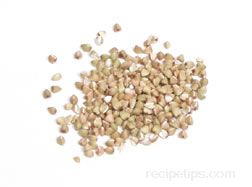




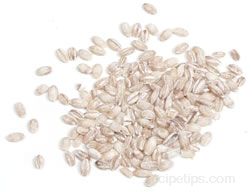
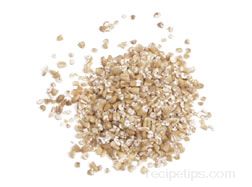
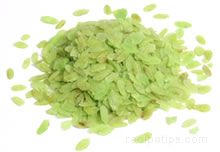
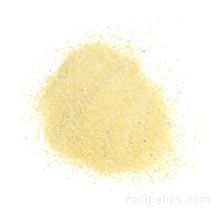
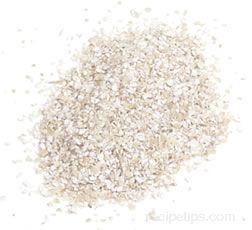
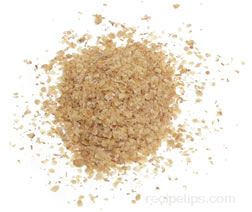
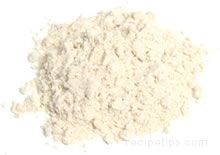
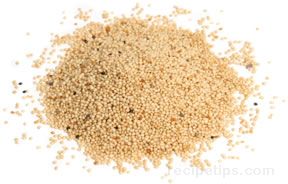 Amaranth is not actually a grain, but an herb, however it is often used as a grain. The plant, which grows as high as 7 feet, has broad leaves, beautiful red flowers, and seed heads that resemble bushy versions of corn tassels. One plant may produce as many as half a million seeds. Amaranth is usually grown as a secondary crop in many areas of the world and most of the production in the United States is limited to Nebraska, Colorado, and Minnesota. The amaranth seed (or grain) is light tan in color and has a very mild tangy or peppery flavor.
Amaranth is not actually a grain, but an herb, however it is often used as a grain. The plant, which grows as high as 7 feet, has broad leaves, beautiful red flowers, and seed heads that resemble bushy versions of corn tassels. One plant may produce as many as half a million seeds. Amaranth is usually grown as a secondary crop in many areas of the world and most of the production in the United States is limited to Nebraska, Colorado, and Minnesota. The amaranth seed (or grain) is light tan in color and has a very mild tangy or peppery flavor.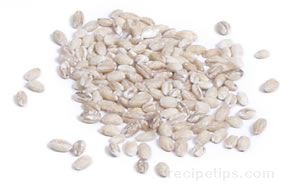 After wheat, rice, and corn, barley is the most important cereal crop in the world. It is very hardy, so it is grown in a variety of climates. Like wheat, it is planted in the spring or fall. It is a staple food crop in Asia and in many of the countries surrounding the Mediterranean. In the United States, the important growing area is the northwest quarter of the contiguous states, extending from Minnesota to Washington.
After wheat, rice, and corn, barley is the most important cereal crop in the world. It is very hardy, so it is grown in a variety of climates. Like wheat, it is planted in the spring or fall. It is a staple food crop in Asia and in many of the countries surrounding the Mediterranean. In the United States, the important growing area is the northwest quarter of the contiguous states, extending from Minnesota to Washington.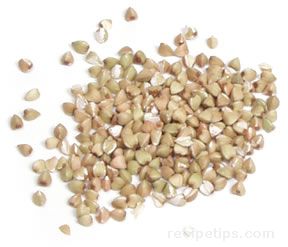 Sometimes considered a cereal grain because it is processed and prepared in similar ways, buckwheat, which is a native plant of Russia, is actually an herb that is related to rhubarb and sorrel. It does not require top grade soil to grow and it can actually do quite well in poor, rocky soil. The crop is ready for harvesting in less than 60 days, so farmers in colder climates are often able to harvest two crops per season. It is also naturally pest resistant and it doesn't require fertilizer to grow properly.
Sometimes considered a cereal grain because it is processed and prepared in similar ways, buckwheat, which is a native plant of Russia, is actually an herb that is related to rhubarb and sorrel. It does not require top grade soil to grow and it can actually do quite well in poor, rocky soil. The crop is ready for harvesting in less than 60 days, so farmers in colder climates are often able to harvest two crops per season. It is also naturally pest resistant and it doesn't require fertilizer to grow properly.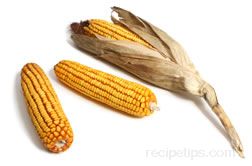
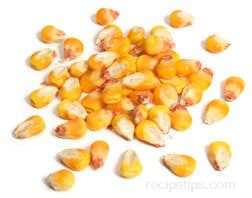
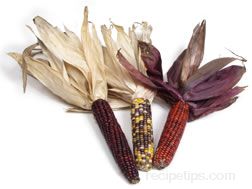 Flint corn is a type of corn that is usually associated with the multicolored ears that are used as a popular decoration in the autumn months. The decorative ears are often referred to as "Decorative Corn" or "Indian corn" and contain kernels of vibrant colors ranging from yellow, orange, and red to blue, purple, and black. The kernels are very hard, but they can be ground into meal and used for human consumption. The Italian dish polenta is most often made from cornmeal ground from flint corn. Hominy, or posole, is usually made from flint corn, as is masa harina, which is dried posole meal, used for making tamales and tortillas.
Flint corn is a type of corn that is usually associated with the multicolored ears that are used as a popular decoration in the autumn months. The decorative ears are often referred to as "Decorative Corn" or "Indian corn" and contain kernels of vibrant colors ranging from yellow, orange, and red to blue, purple, and black. The kernels are very hard, but they can be ground into meal and used for human consumption. The Italian dish polenta is most often made from cornmeal ground from flint corn. Hominy, or posole, is usually made from flint corn, as is masa harina, which is dried posole meal, used for making tamales and tortillas.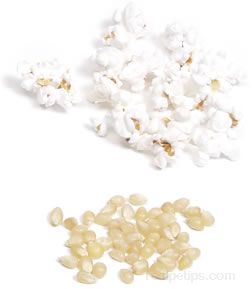
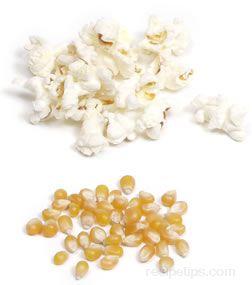
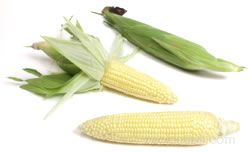 Sweet corn is often considered to be a vegetable rather than a grain because it is most often eaten fresh like a vegetable. Sweet corn has a higher sugar content than other types of corn, but the sugar begins to convert to starch after it is harvested, so it is best when it is eaten fresh. Although there are many different varieties, the three types of sweet corn that are readily available are white corn (white kernels), yellow corn (yellow kernels), and a hybrid of both white and yellow, often referred to as peaches and cream or butter and sugar corn.
Sweet corn is often considered to be a vegetable rather than a grain because it is most often eaten fresh like a vegetable. Sweet corn has a higher sugar content than other types of corn, but the sugar begins to convert to starch after it is harvested, so it is best when it is eaten fresh. Although there are many different varieties, the three types of sweet corn that are readily available are white corn (white kernels), yellow corn (yellow kernels), and a hybrid of both white and yellow, often referred to as peaches and cream or butter and sugar corn.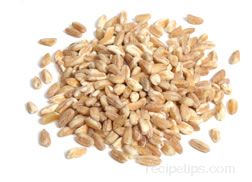 Farro is an ancient Italian grain that is similar in taste to barley. In the United States, farro is known as a type of spelt or wheat. It is a hulled grain, meaning that the hull adheres to the grain when harvested, similar to barley and oats. The hull is then removed during processing. Most people consider farro to be a type of wheat and although they are related, farro is of a different species.
Farro is an ancient Italian grain that is similar in taste to barley. In the United States, farro is known as a type of spelt or wheat. It is a hulled grain, meaning that the hull adheres to the grain when harvested, similar to barley and oats. The hull is then removed during processing. Most people consider farro to be a type of wheat and although they are related, farro is of a different species.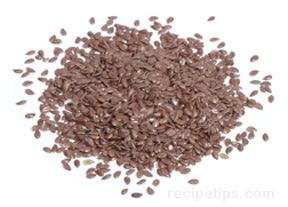 Flax is a plant native to Europe and Asia that is grown for its fiber or its seeds. The plant grows to a height of 4 feet in climates where the summers are cool and moist. Like several other plants that are not really considered grains (amaranth and buckwheat, for example), flax is often used like one. In ancient times, the seeds were ground into flour or meal. Today, this is less common, but flaxseed meal can still be found. The small, brown seeds are more often used as a food additive because of the delicious nutty flavor and the nutritional benefits.
Flax is a plant native to Europe and Asia that is grown for its fiber or its seeds. The plant grows to a height of 4 feet in climates where the summers are cool and moist. Like several other plants that are not really considered grains (amaranth and buckwheat, for example), flax is often used like one. In ancient times, the seeds were ground into flour or meal. Today, this is less common, but flaxseed meal can still be found. The small, brown seeds are more often used as a food additive because of the delicious nutty flavor and the nutritional benefits.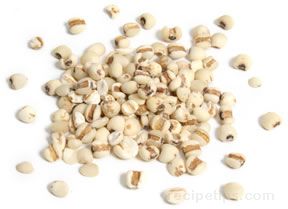 Job's Tears is tall cereal grass cultivated in Asia and Africa, but rarely found in the Western world. The grain is named "Job's Tears" because its shape is similar to a teardrop. When the hull is removed and the grain is polished, it resembles polished barley and it is often considered a form of barley. Like many other grains, Job's Tears can be prepared by boiling or steaming. It can be served as is or it can be added to soups and casseroles.
Job's Tears is tall cereal grass cultivated in Asia and Africa, but rarely found in the Western world. The grain is named "Job's Tears" because its shape is similar to a teardrop. When the hull is removed and the grain is polished, it resembles polished barley and it is often considered a form of barley. Like many other grains, Job's Tears can be prepared by boiling or steaming. It can be served as is or it can be added to soups and casseroles.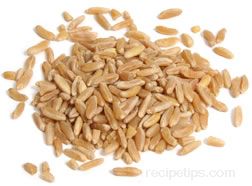 Kamut is a brand name for an ancient Egyptian grain that is closely related to durum wheat and is often considered a specialty grain. Kamut kernels are 2 to 3 times larger than a typical wheat kernel. Most of the Kamut crop in the North America is grown in Montana and adjacent areas of Canada. The grain has a nutty, buttery flavor and is sold as a whole grain, as flour, and in the form of flakes. The delicious chewy grain is excellent in soups, salads, pilafs, or savory side dishes. Kamut wheat is also found in commercially prepared cereals, crackers, and breads and like durum wheat, it is excellent for pasta making.
Kamut is a brand name for an ancient Egyptian grain that is closely related to durum wheat and is often considered a specialty grain. Kamut kernels are 2 to 3 times larger than a typical wheat kernel. Most of the Kamut crop in the North America is grown in Montana and adjacent areas of Canada. The grain has a nutty, buttery flavor and is sold as a whole grain, as flour, and in the form of flakes. The delicious chewy grain is excellent in soups, salads, pilafs, or savory side dishes. Kamut wheat is also found in commercially prepared cereals, crackers, and breads and like durum wheat, it is excellent for pasta making.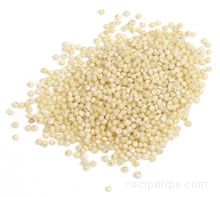
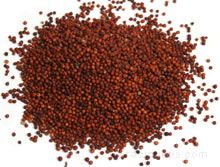
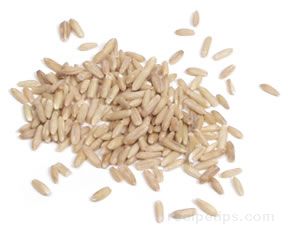 The oat plant thrives in temperate climates, preferring cool, moist conditions and it is able to grow in areas where other important cereal grains, such as wheat and corn, do not grow well. In the Untied States, the northern tier of states provides a majority of the oat crop in the country. Winter oats and summer oats are the two main classifications into which the hundreds of varieties are grouped. The color of the different varieties ranges from light beige or yellow grains to reddish-gray and black. When oat grains are processed, the outer hull is removed, but the nutritious bran and germ are kept.
The oat plant thrives in temperate climates, preferring cool, moist conditions and it is able to grow in areas where other important cereal grains, such as wheat and corn, do not grow well. In the Untied States, the northern tier of states provides a majority of the oat crop in the country. Winter oats and summer oats are the two main classifications into which the hundreds of varieties are grouped. The color of the different varieties ranges from light beige or yellow grains to reddish-gray and black. When oat grains are processed, the outer hull is removed, but the nutritious bran and germ are kept.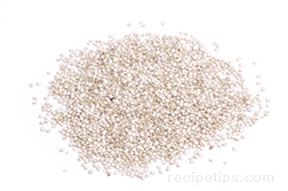
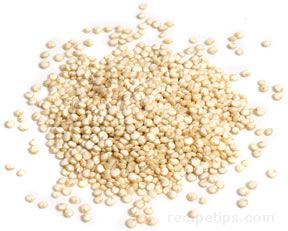
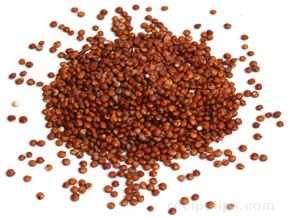
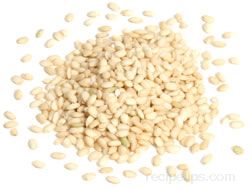 Rice is such an important part of the diet of half the world's population that nearly 50% of their daily intake of calories is provided by it. Rice is grown in river deltas, flooded or irrigated coastal plains, or terraced hillsides. It can be grown in many climate conditions, but it is most often cultivated in subtropical locations and in temperate areas with long, hot and humid growing seasons. There are thousands of varieties of rice and many of the plants grow as high as 12 feet.
Rice is such an important part of the diet of half the world's population that nearly 50% of their daily intake of calories is provided by it. Rice is grown in river deltas, flooded or irrigated coastal plains, or terraced hillsides. It can be grown in many climate conditions, but it is most often cultivated in subtropical locations and in temperate areas with long, hot and humid growing seasons. There are thousands of varieties of rice and many of the plants grow as high as 12 feet.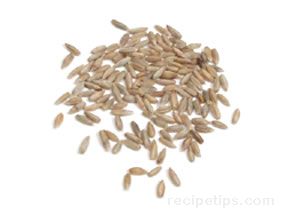 Rye is the one of most widely used grains in many of the northern and eastern European countries including much of Scandinavia and Russia, due in part to the cool climate, which is not suitable for growing wheat. Rye grain has a very assertive and hearty flavor with a slightly bitter taste. The color of the grain may range from beige to dark gray.
Rye is the one of most widely used grains in many of the northern and eastern European countries including much of Scandinavia and Russia, due in part to the cool climate, which is not suitable for growing wheat. Rye grain has a very assertive and hearty flavor with a slightly bitter taste. The color of the grain may range from beige to dark gray.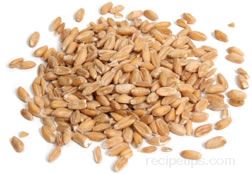 Spelt is an ancient cereal grain related to modern wheat that originated in southern Europe. Many people think of spelt as a type of wheat and although they are of the same family, spelt is of a different species. It was widely cultivated in the United States at the end of the 19th century, but it became less popular when new high yield varieties of wheat were developed. Spelt also lost favor in the United States because converting the grain into flour requires more time than processing wheat flour. The outer hull of the spelt grain remains intact until the grain is processed, which contributes to the additional time required when milling spelt. This differs from wheat, which looses its hull when it is harvested. Although in terms of processing, it is a disadvantage for the hull to remain on the grain after harvesting, there are advantages as well. The hull protects the kernel from insects and pollutants and it also allows the grain to maintain freshness and retain its full flavor and nutrients.
Spelt is an ancient cereal grain related to modern wheat that originated in southern Europe. Many people think of spelt as a type of wheat and although they are of the same family, spelt is of a different species. It was widely cultivated in the United States at the end of the 19th century, but it became less popular when new high yield varieties of wheat were developed. Spelt also lost favor in the United States because converting the grain into flour requires more time than processing wheat flour. The outer hull of the spelt grain remains intact until the grain is processed, which contributes to the additional time required when milling spelt. This differs from wheat, which looses its hull when it is harvested. Although in terms of processing, it is a disadvantage for the hull to remain on the grain after harvesting, there are advantages as well. The hull protects the kernel from insects and pollutants and it also allows the grain to maintain freshness and retain its full flavor and nutrients.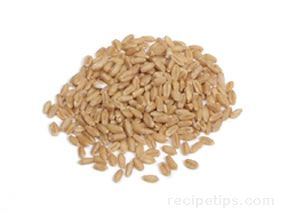 In addition to rice and corn, wheat is one of the three most important grain crops in the world. Unlike some grains (especially corn), most of the wheat that is cultivated is used as food for humans. There are thousands of varieties grown in many parts of the world. The wheat plants grow to height of 4 feet or more and the mature grain is approximately one-quarter inch in length. Most wheat is grown in temperate climates, with a large portion grown in the Great Plains region of the United States, an area also known as the "breadbasket of the world".
In addition to rice and corn, wheat is one of the three most important grain crops in the world. Unlike some grains (especially corn), most of the wheat that is cultivated is used as food for humans. There are thousands of varieties grown in many parts of the world. The wheat plants grow to height of 4 feet or more and the mature grain is approximately one-quarter inch in length. Most wheat is grown in temperate climates, with a large portion grown in the Great Plains region of the United States, an area also known as the "breadbasket of the world".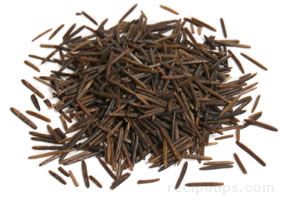 Wild rice is not actually a type of rice, but an aquatic grass bearing edible seeds that grows wild in marshy areas of lakes and rivers. Wild rice is native to the northern waters of Minnesota, parts of Wisconsin, and adjacent areas of Canada. For the Native Americans of the area, wild rice is known as "Mahnomen" (or manomin) meaning, "good berry". It is manually harvested, which makes true wild rice quite expensive. Cultivated wild rice is less expensive, but it is grown in controlled paddies, most of which are located in California and Minnesota. Only about one-tenth of the wild rice harvested in Minnesota is true hand-harvested lake rice.
Wild rice is not actually a type of rice, but an aquatic grass bearing edible seeds that grows wild in marshy areas of lakes and rivers. Wild rice is native to the northern waters of Minnesota, parts of Wisconsin, and adjacent areas of Canada. For the Native Americans of the area, wild rice is known as "Mahnomen" (or manomin) meaning, "good berry". It is manually harvested, which makes true wild rice quite expensive. Cultivated wild rice is less expensive, but it is grown in controlled paddies, most of which are located in California and Minnesota. Only about one-tenth of the wild rice harvested in Minnesota is true hand-harvested lake rice.


